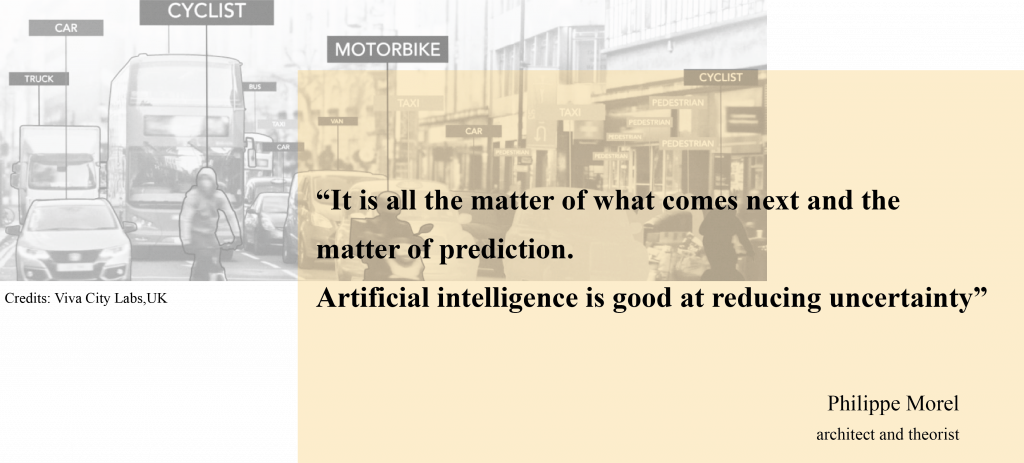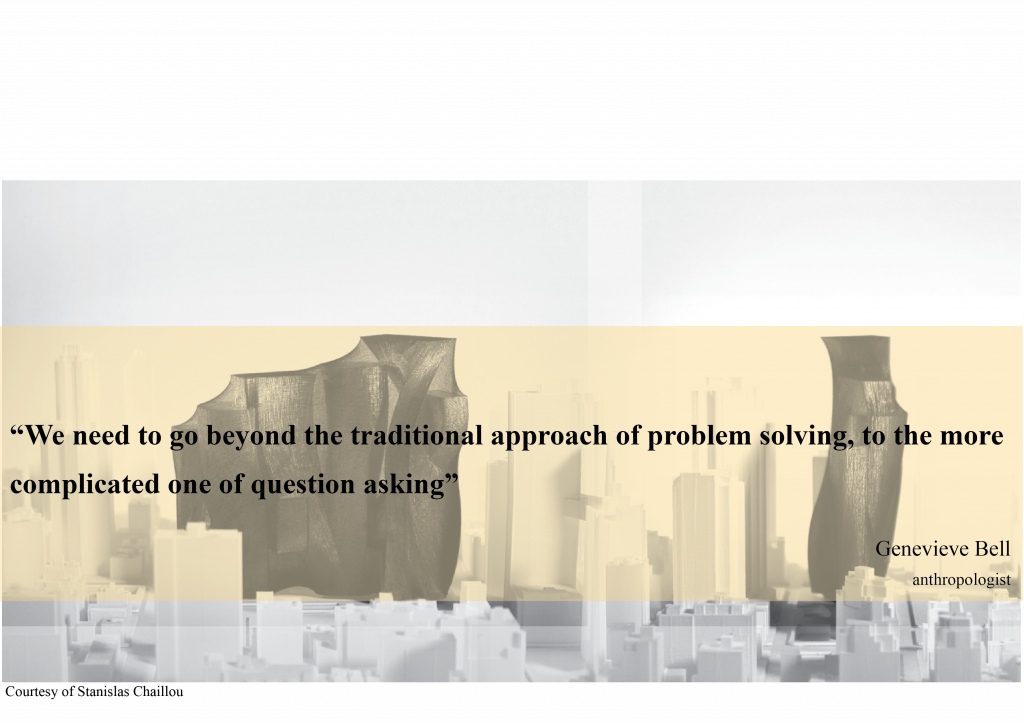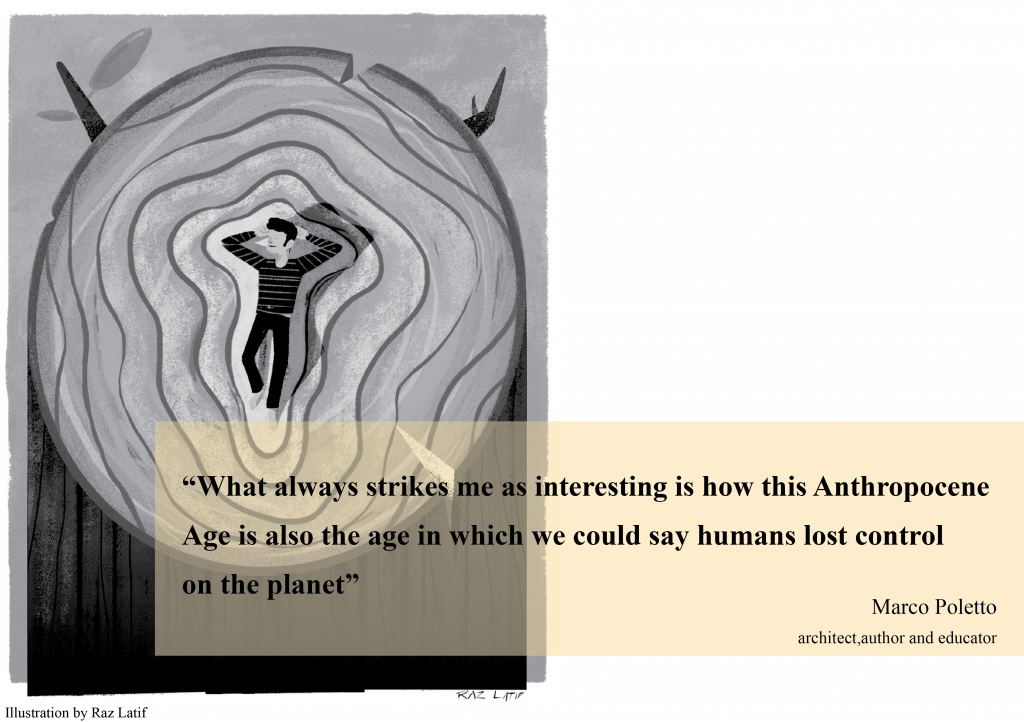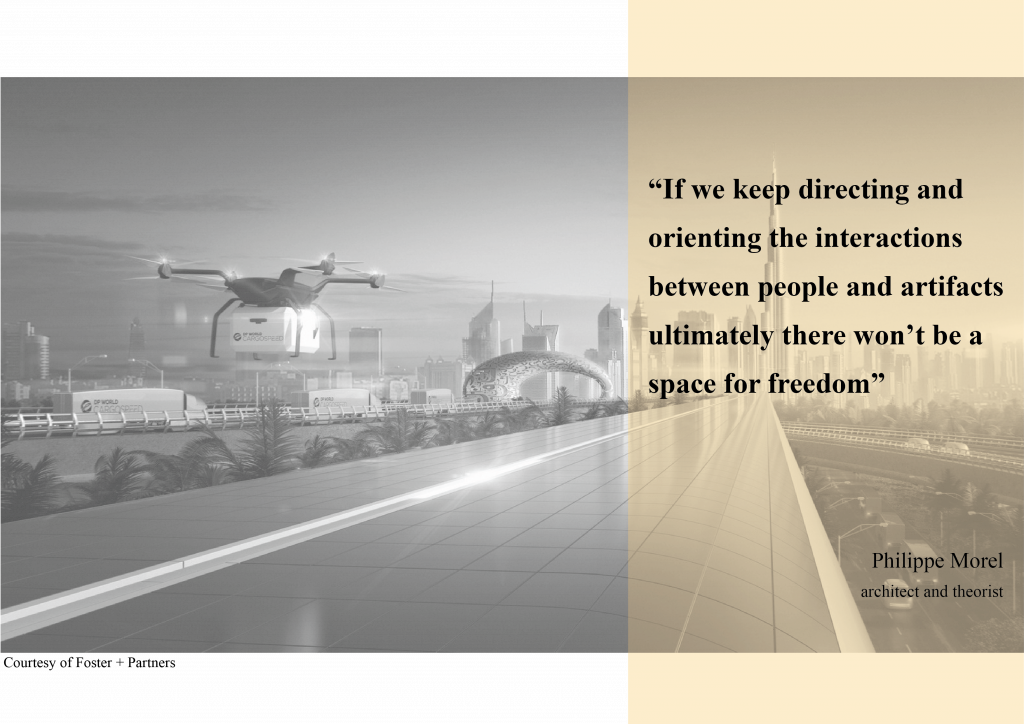Artificial Intelligence for Ecological Change
Preface
The main objective of this study is to perform a critical reflection on a topic in relation to cities and technology. Following the literature review, with a holistic approach to the research, we had direct contact with professionals from different disciplines, to get their support on drawing a framework as a base for the research, understanding main challenges in shaping future cities and evaluating possible solutions.
We would like to express our gratitude to Marco Poletto, Gonzalo Delacámara, Philippe Morel and José Luis de Vicente for participating in our interviews and sharing their valuable time and experiences with us.
Abstract
Knowingly or unknowingly, Artificial Intelligence has become part of our lives. Today, the general applications of AI seem to be shaped around humans, and in search for how to use it in our artificial built environments seeking for our own safety and accommodation. Although making our cities eco-friendlier seems one of the main ideas in designing future cities, all the technological solutions proposed do not seem to be enough to solve the major problems that humanity is facing. As Genevieve Bell explains: “We need to go beyond the traditional approach of problem solving, to the more complicated one of question asking”. Possibly, the addition of AI as a layer to our current urban infrastructure will help us to make our cities more green, sustainable, and efficient.
Our new concern should be focused on how to create an ecological thinking that restores the relationship between human and the biosphere or, artificial and natural. The new layer of infrastructure created for Artificial Intelligence should help promoting mechanisms that allow the creation of new ecosystems, where humans could abandon their parasitic condition to establish a symbiotic relationship with nature.
Background
In the wake of 21st century we are at a crucial moment of our planet. Technological advances have ushered us an unprecedented economic, social and technological growth in the last century. At the same time there has been undeniably great damage done to the natural ecosystems to a point from which there seems to be no return.
Cities are one of the greatest inventions of the human being. They are economic, technological, and innovative driving forces. Likewise, cities also exemplify the dark side of human ecosystems: They emit 70% of the CO2 in the planet, sources of pollution and waste and hoarder of basic resources, goods, and services. Cities have exemplary contribution in disrupting the lifecycles.
We project cities of the future into a future that is beginning to be uncertain; and due the new ecological worldwide concern which questions the future of cleaner, safer, more efficient, and more sustainable cities.
The promise of the sustainability and efficiency of our cities is based, paradoxically, on the dizzying speed of the evolution of technologies. And the last great leap, which began with the digital revolution, is Artificial Intelligence.
Today everything is guided and driven by AI adding more creativity and complexity in understanding complex human behavioural patterns. The wide application of this technology in almost all fields triggers fears of its aftermaths and the future. This new layer of intelligent infrastructure it’s starting to be added in our lives and cities beyond our own perception. The new layer of infrastructure created through Artificial Intelligence should help promote mechanisms that allow the creation of new ecosystems, where humans could abandon our parasitic condition to establish a symbiotic relationship with nature. Cities behave more integrated biological systems that can receive at the same time they provide. Cities where there is no split between the urban and artificial, landscape and nature.
Interview Reflections
Nature in Anthropocene Era
The Anthropocene is a geological period to describe significant human impact on Earth’s geology and ecosystems that is largely associated anthropogenic climate change. Although some sources point to the Agricultural Revolution as the beginning of the Anthropocene Era, there are different opinions. As one of them, we consider the Anthropocene Era as the process from the Industrial Revolution, when the effect of humans on the Earth reached its highest level, to the present.
Current studies suggest that the period since the middle of the 20th century should be accepted as a different geological period from the Holocene, and it can be said that theoretical and applied ecology has developed as a discipline of knowledge in parallel with the new trends and frame of mind, as well as increasing debate and differences of opinion. While the lack of correlation between socio-economic research and ecological research was felt until a short time ago; this correlation has been strengthened, especially with the adoption of a new research program on ecosystem services. Natural systems, which are frequently on the agenda with the Anthropocene era debates, the awareness they require and their complex, dynamic and adaptive structures have also begun to be considered for social systems.
If we look at the course of anthropogenic climate change in the last two decades, we can say that the ecological crisis has caused the extinction of biological diversity and ecosystems. When we look at the last fifty years, we can consider the intense consumption of natural resources and the accelerating CO2 emissions along with it, as evidence of anthropogenic climate change.
It would not be wrong to say that what we, as human beings, need a kind of transformation in our way of thinking. As José Luis de Vicente mentioned in the interview: “It is the transformation that makes us adopt the idea of, humans as a form of life are not above the rest of life on which we depend.” And as he explains, this transformation is highly dependent on how we recognize the value. Just as we recognize value economically, in order to strengthen our human well-being or social welfare, we need to develop a value judgment for the protection of biodiversity and ecosystems, reducing CO2 emissions and fight against climate change. The other option is that we will continue to monitor the unintended consequences of the Anthropocene Era until it reaches a level that cannot be changed.
Power of AI in Problem Solving
One could say that there has been a revolution of some kind in machine learning and deep learning technologies since 2013, that resulted in a fascination towards the field of artificial intelligence. The floor is somehow slippery here. If you are to get on board with the idea of a fourth industrial revolution, and the technological advancements underneath it, then you might feel the urge to see techniques that fall under the A.I. umbrella as the answer to every problem. To argue that specific advancements in this area can suddenly change everything is problematic, since problems we often face are complex and multi-dimensional. Expecting technological innovations to one of these dimensions to create ripple effects that automatically improve all the other dimensions is not how things work in reality. One should perceive AI as a way of complementing and expanding our current problem-solving processes on these dimensions, not one to substitute them.
A particular dimension in which Artificial Intelligence has been highly influential is the dimension of uncertainty. Interestingly, looking at a plethora of disciplines, one could interpret previous approaches to the city, or say, socio-economic patterns, as biased towards mitigating uncertainties. AI has been revolutionary in applied sciences that deal with uncertain systems. It provides a framework within which we can process the uncertainty and arrive at predictions. It is thus safe to say, that we now have the necessary analytical tools to face some of the challenges we had in dealing with uncertainty. It is, however, important that we move away from those approaches that try to mitigate uncertainty and accept that uncertainty is here to stay. We just need to deal with it in a different way, which now we are capable of.
Much like how AI helps us make use of uncertainty, it allows us to make use of nature itself. We are masters of the nature to the extent that we understand its rules; and by understanding how it functions, we are capable of controlling it. Deep learning systems allow us to learn things about the functioning of nature that we simply were not capable of learning before, and we can make use of this knowledge, to engineer nature in a way. The recent work of Marco Poletto and colleagues, the “Deep Green” project specifically demonstrates how Ai generated algorithms could create and generate visions and create a labyrinth for the future of cities. This machine learning algorithm is inspired by prediction and optimization qualities of Physarum Polycephalum an organism. Ability to train machine learning behavior of the biological organism and embed it into the computing realm was a breakthrough of the 21st century. The transformation of the embedded intelligence of organisms into the computational world has opened up possibilities to generate creative and optimized solutions in creating the network of lifecycles in the urban biosphere.
Future Challenges of AI
Based on our learning from today, the possible challenge for the future should be shaping and training a bigger form of artificial intelligence that appears across the urban space and spreads to different global ecosystems having the ability to cope with multiple conditions.
As professionals working on shaping the future of cities and creating livable spaces, we should see artificial intelligence as an experience beyond what we can do on a local scale and with limited resources. An experience that we can all shape, will be able to cope with complexity of urbanization and the problems that come up with it, and will make this complexity more visible and resolvable.

In order to train a bigger form of intelligence, we need a holistic view to address supranational challenges, away from fragmented institutions or institutions with very old-fashioned mandates, which are insufficient to address today’s challenges. Artificial Intelligence, and perhaps many new technologies that we will meet in the near future, have the power and scope to tackle supranational challenges, for example better management and equitable use of natural resources, and dealing with ecological crises.
To conclude, in the next 10 or 20 years, as Phillippe Morel has stated, it can be expected that artificial intelligence will have the same impact that the invention of electricity previously had in our lives. As he explained, we think we should try to use artificial intelligence to suggest new interaction models. If we continue to limit and direct the interaction between Nature and humans, or artifacts and humans, instead of defining new relationships, ultimately there will not be a space of freedom.
Video :Artificial Intelligence for Ecologic Change – YouTube
Document could be found on ISSUU:
References:
Ellen P.Goodman & Julia Powles,”Urbanism Under Gogle: Lessons from Sidewalk Toronto”,2019
Fabio Duarte & Ricardo Alvarez,Massachusetts University of Cambrdge MA,United States;”The Data Politics of Urban Age” Article by Plagrave Communications,28th may 2019
Fraser,J.(2019,August 06).The Reshaping Of City Cores That Were Designed For Cars
Filiano,G.(2017,March 31).This is how long it would take for nature to restore species to pre-human levels.
Genevieve Bell:6Big Ethical Questions About the future of AI : TED Talk
Munoz,J.,& Naqvi,A.(2017).Artificial Intelligence and urbanization:The Rise of Elysium Cty.journal of Economics and Political Economy,4,1-13.
Artificial Intelligence for Ecological Change is a project of IAAC, Institute for Advanced Architecture of Catalonia developed at Master in City & Technology in 2020/21 by students: Sinay Coksun, Adriana Aguirre Such,Tugdual Sarazin & Kshama Patil and faculty: Mathilde Marengo


